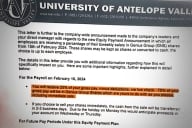You have /5 articles left.
Sign up for a free account or log in.
Nearly 1 million student veterans used $10.9 billion in education benefits from the U.S. Department of Veterans Affairs to attend college in 2011, according to a new report from the U.S. Government Accountability Office.
The study released Thursday gives perhaps the most in-depth picture of the college-going patterns of large numbers of veterans who are returning from Afghanistan and Iraq. And while it does not name individual colleges, the report includes separate numbers for the for-profit, public and private nonprofit sectors.
The largest source of education funding for veterans is the Post-9/11 G.I. Bill, which accounted for $8.5 billion of all such payments in 2011. Other programs include the Montgomery G.I. Bill and the Survivors’ and Dependents’ Educational Assistance Program.
Spending on the Post-9/11 G.I. Bill is increasing rapidly -- by 50 percent in 2011. And the “return on investment” for those benefits has become a hot topic in Washington. In particular, some Congressional Democrats have been fiercely critical of how the for-profit industry recruits and serves student veterans.

A small group of institutions is receiving the bulk of veterans’ education benefits that go toward tuition and fees, according to the study. About 5 percent of the nation’s colleges and universities received 60 percent of all Post-9/11 G.I. Bill tuition benefits, the report found. Those 654 institutions received a total of $3.8 billion, with individual colleges receiving between $2 million and $113 million.
Public and for-profit institutions received roughly same amount of all Post-9/11 GI Bill tuition payments over all. But among the small group of colleges that received a high volume of payments, for-profits got the biggest piece of the pie. Those for-profits also received the highest Post-9/11 G.I. Bill payments per veteran, the study found.
Public institutions enrolled the most veterans, according to the report, and had the lowest Post-9/11 GI Bill payments per veteran. Those payments were half the amount, on average, of those received at for-profits.
For-profits received an average Post-9/11 G.I. Bill payment of $10,000 for each of the 99,000 student veterans they served in 2011. Public institutions received $5,000 on average for the 174,000 they served.
The study attempted to shed some light on student success rates at the colleges that veterans attend. But the data were not specific to student veterans, and the report instead included retention and graduation rates for all students at institutions within each sector.
Over all, student veterans generally fared better at institutions that enroll large numbers of their peers. The group of colleges that received at least $2 million in Post-9/11 G.I. Bill tuition payments had better completion rates and similar student loan default rates as the other institutions in the sample.
The study found a mixed picture of student success rates across the various sectors. That finding was influenced by the relatively high number of disadvantaged student veterans who attend for-profits.
“Within the highly Veterans Administration-funded group of schools, for-profit schools had higher proportions of low-income and minority students, along with mixed outcomes in retention, graduation and default rates, compared to public and nonprofit schools,” the study said. Private colleges “had the lowest percentage of low-income students and public schools had the lowest percentage of minority students.”
After controlling for those differences, student outcomes continued to vary across the sectors. For-profits tended to have higher graduation rates than public institutions, for example, but also higher loan default rates.
For-profit colleges are not permitted to receive more than 90 percent of their revenue from federal sources. But government education benefits for veterans and active-duty members of the military do not count as federal sources under the so-called "90/10 rule."
Not surprisingly, the GAO report found that for-profits receiving relatively large amounts of Post-9/11 G.I. Bill payments were unlikely to hover near the 90 percent cap.
"In other words, highly Veterans Administration-funded for-profit schools had lower 90/10 rates in the aggregate than other for-profit schools," the study said, "meaning that they received proportionally less federal student aid than other for-profit schools.”





